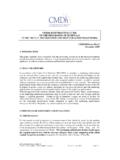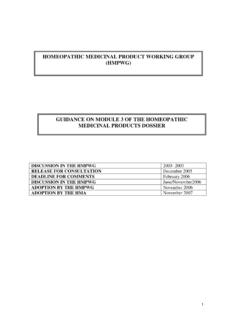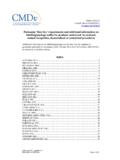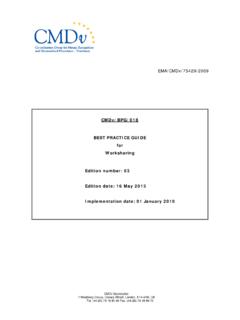Transcription of BEST PRACTICE GUIDE For Type IB Variations CMDv/BPG/005 ...
1 EMA/CMDv/115405/2006. BEST PRACTICE GUIDE . For Type IB Variations CMDv/BPG/005 . Edition 05. Edition date: 10 April 2015. Implementation date: 10 April 2015. CMDv/BPG/005 . BEST PRACTICE GUIDE . Ed.: 05. For Type IB Variations Page 2 of 10. Index 1. Introduction 2. Aim and Scope 3. Reference documents and/or related documents 4. Type IB Notification procedure: Pre-submission phase Submission phase Validation phase Start of notification procedure Evaluation phase Outcome of the notification procedure Annexes 1. Examples of: Acceptance of a Type IB notification Rejection of a Type IB notification 2. Flow Chart for Type IB Variations EMA/CMDv/115405/2006 Page 2 of 10. CMDv/BPG/005 . BEST PRACTICE GUIDE . Ed.: 05. For Type IB Variations Page 3 of 10. 1. Introduction This Best PRACTICE GUIDE is the consequence of the implementation of Commission Regulation (EC) No. 1234/2008 effective from 1 January 2010.
2 According to the Regulation a variation, which is not an extension and which is not classified in the Commission guideline on the details of the various categories of Variations referred to in Article 4 of the Regulation, shall by default be considered a Type IB variation. The guideline contains examples of changes that are considered Type IB. Variations . Furthermore, a variation published as a Type IB variation following an Article 5 recommendation shall be submitted as such. A. recommendation for classification as a Type IB variation received by the CMDv shall also be submitted as such. Type IB Variations require prior approval before implementation known as the Tell, Wait and Do procedure. Type IB Variations may be grouped together with other Variations in a single notification. If the highest ranking variation is a Type IB variation, this will be classed as a Type IB lead grouped variation.
3 Further information about the grouping of Variations is available in Best PRACTICE GUIDE of Grouping of Variations (CMDv/BPG/016); however, the timetable and principles for a Type IB lead grouped variation is the same as the procedure outlined in section 4 of this document. A marketing authorisation holder (MAH) may also submit several Type IB. and/or Type II Variations to one or more of their products in a single application; this will be dealt with in accordance with the worksharing initiative. Further information about work sharing is available in Best PRACTICE GUIDE for Worksharing (CMDv/BPG/018); however, regardless of the types of Variations included in the application, the timetable and principles for worksharing are the same as those used for Type II. Variations (see Best PRACTICE GUIDE for Type II Variations CMDv/BPG/006). 2. Aim and Scope This Best PRACTICE GUIDE has been produced by the CMDv in order to facilitate the processing of Type IB Variations in the Mutual Recognition (MR) procedure.
4 Guidance is given on the role of the Reference Member State (RMS), the Concerned Member State(s) (CMS) and the applicant to ensure that a consistent, timely and efficient procedural approach is maintained. It is noted that the quality of the applicant's submission EMA/CMDv/115405/2006 Page 3 of 10. CMDv/BPG/005 . BEST PRACTICE GUIDE . Ed.: 05. For Type IB Variations Page 4 of 10. package (application form and supporting documents) is considered crucial to the overall process. 3. References and related documents Regulation 1234/2008 concerning the examination of Variations to the terms of a marketing authorisation for medicinal products for human use and veterinary medicinal products granted by a competent authority of a Member State. NTA - Volume 6A - Chapter 5. Commission guideline on the details of the various categories of Variations . Best PRACTICE GUIDE on Grouping of Variations .
5 Best PRACTICE GUIDE for Worksharing. SOP for the allocation of mutual recognition/decentralised procedure application number. Best PRACTICE GUIDE for Type II Variations . 4. Type IB Notification Procedure Pre-submission phase The MAH will contact the RMS at least seven days prior to submission in order to obtain the Type IB variation procedure number. In cases of doubt about the classification, the MAH, the RMS or the CMS may request the CMDv to provide a recommendation on the classification of the variation according to article 5 of Regulation (EC) No 1234/2008. Submission phase The MAH will submit simultaneously to the RMS and CMS an application containing the elements listed in Annex IV of the EMA/CMDv/115405/2006 Page 4 of 10. CMDv/BPG/005 . BEST PRACTICE GUIDE . Ed.: 05. For Type IB Variations Page 5 of 10. Regulations, presented as follows in accordance with the appropriate headings and numbering of the NTA Vol 6B format (veterinary medicinal products): Cover letter (including variation procedure number).
6 Application form (with variation procedure number completed on page 1) including the details of the MA(s) concerned. Where a variation is the consequence of another variation, a description of the relation between these Variations should be provided in the appropriate section of the application form. A copy of: o a checklist of the documentation specified for the proposed change(s). This could be directly copied or printed from the Commission Guideline, if applicable. o or a copy of the relevant published Article 5. recommendation, if applicable. o or recommendation for classification received from the CMDv. Supporting documentation as appropriate. o For Variations requested by a national competent authority, following assessment of Follow Up Measures (FUMs), Specific Obligations (SOs) and Periodic Safety Update Reports (PSURs), or class labelling, a copy of the request should be annexed to the cover letter.
7 O For Variations that affect the SPC, labelling or package leaflet, both the English texts and national translations should be submitted. Mock-ups or specimens should be provided according to according to guidance on the CMDv website or as discussed with the RMS on a case- by-case basis Additionally, the MAH should submit a list of dispatch dates to the RMS indicating the Type IB variation procedure number, the dates on which the applications were sent to the RMS and the CMS, and confirmation that the relevant fees have been paid as required by each national competent authority. Within seven days the RMS creates the CTS record and sends an email via the MRVE mailbox to inform the CMS about the new procedure. EMA/CMDv/115405/2006 Page 5 of 10. CMDv/BPG/005 . BEST PRACTICE GUIDE . Ed.: 05. For Type IB Variations Page 6 of 10. Validation phase The RMS and CMS will check whether the notification is correct and complete ( valid') within seven days prior to the start of the evaluation procedure.
8 CMS should send any comments about an invalid notification to the RMS within this time frame. Start of notification procedure (Day 0). Following the validation period the RMS completes the CTS record and sends an email via the MRVE mailbox informing the CMS of the validation outcome. If the notification is considered valid, the RMS will also inform the CMS and MAH of the timetable and start date. Evaluation phase (Day 0 to 30). Within 30 days from the start of the notification procedure, the RMS will notify the MAH of the outcome of the procedure. If the RMS has not sent the holder its opinion within 30 days, by Day 30, the notification shall be deemed acceptable. The responsibility for the evaluation of the proposed variation lies with the RMS; however, in the exceptional circumstances outlined below, the RMS should seek comments from the relevant CMS. before reaching a decision. If there are objections from the CMS, they should update CTS and send their comments to the RMS.
9 Within 20 calendar days from the start of the procedure. This situation may be given for the following change: Change in the name of the medicinal product (in a CMS). Change in or introduction of a DDPS (in a CMS). All Variations under heading and Variations under heading and Changes to the labelling and PL that do not represent changes to the harmonised labelling/PL-text, such as changes to layout of information or languages included on packs and in package leaflets, are outside the scope of this BPG. Such changes should not be submitted via the RMS but be submitted to and agreed with the Member States concerned according to their national procedures and requirements If the notification cannot be accepted by all member states, the RMS will inform the MAH and the CMS about the grounds on EMA/CMDv/115405/2006 Page 6 of 10. CMDv/BPG/005 . BEST PRACTICE GUIDE . Ed.: 05. For Type IB Variations Page 7 of 10.
10 Which the rejection is based ( Notification with grounds') by Day 30. The clock will stop pending receipt of an amended notification by the MAH, which should be submitted to the RMS and CMS. within 30 calendar days. Additionally, the MAH should send a list of the dispatch dates to the RMS, indicating the dates on which the amended notification was sent to the CMS. The RMS will re- start the procedure on receipt of the list of dispatch dates and inform the MAH accordingly. The RMS will also update CTS and send an email to the MRVE mailbox informing the CMSs of the start date (New Day 0). MAH are reminded that if the product information is concerned by the change applied for, national translations updated in accordance with requests for amendment raised in the Notification with grounds, have to be submitted in the amended notification in order to be validated during this second 30-day period.










